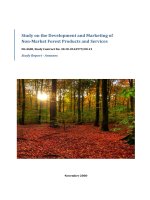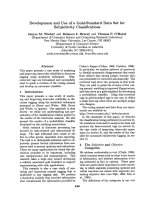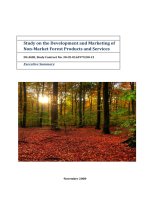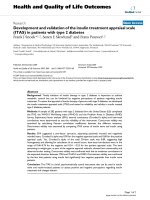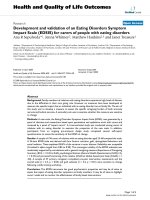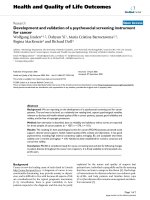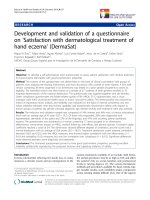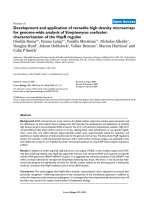Development and standardization of knowledge scale on hygiene for rural women
Bạn đang xem bản rút gọn của tài liệu. Xem và tải ngay bản đầy đủ của tài liệu tại đây (195.69 KB, 5 trang )
Int.J.Curr.Microbiol.App.Sci (2019) 8(3): 145-149
International Journal of Current Microbiology and Applied Sciences
ISSN: 2319-7706 Volume 8 Number 03 (2019)
Journal homepage:
Original Research Article
/>
Development and Standardization of Knowledge Scale on
Hygiene for Rural Women
Ingita Gohain* and Juliana Sarmah
Department of Extension and Communication Management,
Assam Agricultural University, Jorhat, Assam, India
*Corresponding author
ABSTRACT
Keywords
Hygiene,
Knowledge, Rural
women
Article Info
Accepted:
04 February 2019
Available Online:
10 March 2019
The present study was aimed to construct, develop and standardize a Knowledge Scale on
Hygiene. After going through several related literature, the researcher outlined a scale and
after analyzing, the content framed 90 items related to the course. The prepared 90 items
were revised and edited carefully and then given to a panel of experts in the field of health,
hygiene and extension specialist for their valuable suggestions and corrections to ensure its
quality. Thus the content validity of the tool was established. After seeking the opinion of
the experts some of the items were reframed. Finally, 73 items were considered to form
initial test battery for developing a standardized knowledge test. These items were
subjected to item analysis. After which, a total of 30 items were remained for the final
study. Simple random sampling method was adopted for the selection of 90 samples for
standardization of the knowledge check. Item Analysis was done by calculating the
Difficulty Index level and Discrimination Index Level of the 73 items.
behaviour in particular, like hand washing
with soap at critical times: after defecating
and before eating or preparing of food
(Sarmah and Sithalakshmi, 2001). According
to WHO, hand washing with soap can
significantly reduce the incidence of diarrhea,
which is the second leading cause of death
amongst children less than five years old.
Ansari and Gupta (2015) study found that
there was a significant improvement in the
knowledge score for 100 health care workers
(56 doctors and 44 nurses) after the training
sessions. A study done by WHO also reveals
that good hand washing practices helps to
reduce the incidence of other diseases like
pneumonia, trachoma, scabies, skin and eye
infections and diarrhea related diseases like
Introduction
Hygiene practices play a vital role in the
health status of human society. Health status
of an individual reflects the quality of life.
Health is one of the essential natural prerequisite for every person to lead a successful
life. Access to improved water and sanitation
facilities does not, on its own, necessarily lead
to improved health. Evidences have shown
that good hygiene practices are very
important in the health status of people. Lack
of proper hygiene has been the major cause of
many killer diseases in most countries of the
world, including India (Garrett and
Woodworth, 1981). To maintain hygiene, one
must know the importance of hygienic
145
Int.J.Curr.Microbiol.App.Sci (2019) 8(3): 145-149
cholera and dysentery. The hygienic
behaviour can be promoted through
motivation, information and education.
Before promoting information on hygiene, it
was felt necessary to know the knowledge
level on hygiene among the rural women
(Chamyal, 2018).
experts of relevant field and different
literatures were reviewed to form initial test
battery to carry out the item analysis.
The prepared item pool was subjected to
scrutiny by a panel of experts (20 nos.) in the
field of health, hygiene and extension
specialist. The content validity of the
knowledge statements were judged in terms
of clarity/ambiguity and relevancy. As per
judgment of panel of experts on the
knowledge statements, 17 items were
eliminated. Finally, 73 items were selected to
form initial test battery for developing a
standardized knowledge test. All the selected
items were in „objective‟ form having
dichotomous (correct/incorrect) type of
statements.
Everybody knows that women are the
backbone of a society. The success of any
programme depends on the cooperation of the
women. As Nehru said, “to awaken the
people, it is the woman who must be
awakened and once she is on move, then the
family moves, the village moves and the
nation moves.” Thus, if the knowledge level
of rural women on hygiene is assessed, then
varieties of educational programme can be
undertaken for the rural women based on their
knowledge level, which in turn will help them
to improve their health status in general.
Therefore, the researchers have decided to
make an attempt to construct and standardize
the Knowledge Scale on Hygiene for rural
women.
Administration of knowledge scale on
selected sample
The items were finally administered to 90
rural women selected randomly from three
non sampled villages of Jorhat district of
Assam. Scores of 1(one) and 0 (zero) were
given for correct and incorrect responses
respectively. Therefore, there was a
possibility of respondents scoring the
maximum points for all correct answers and
zero points for all wrong answers. Thus the
range of obtainable score was 0-73 after
computing the total scores obtained by each
of the respondents (Table 1).
Materials and Methods
For the present study, the following
procedures were followed for preparing the
draft tool, administration of the tool and
sampling method.
Sample
Item analysis
For the study, a total of 90 rural women were
selected as respondents belonging to
reproductive age group (15 yrs – 45 yrs) from
three non sampled villages of Jorhat district.
For selection of sample, random sampling
technique was adopted.
The scores obtained by the 90 respondents
were arranged in descending order of the total
scores and the respondents were divided into
six equal groups – G1, G2, G3, G4, G5 and
G6 with 15 respondents in each group. For the
purpose of item analysis, the middle two
groups namely G3 and G4 were eliminated
retaining only the four terminal groups with
high scores (G1 and G2) and with low scores
(G5 and G6).
Preparation of the draft tool
Based on the content area ninety (90)
statements were prepared by consulting with
146
Int.J.Curr.Microbiol.App.Sci (2019) 8(3): 145-149
was estimated since the items were scored
simply as 1 if correct and 0 if incorrect.
According to Garrett (1981) point biserial „r‟
assume that the variable, which has been
classified into two categories, can be thought
of as concentrated at two distinct points along
a graduated scale or continuum. The formula
for the point biserial r is:
Item difficulty index (P)
The next step is to determine the Item
Difficulty Index. Item difficulty was
determined by the percentage of individuals
who were able to pass each item. The index of
item difficulty indicated the extent to which
an item was difficult. Practically, if an item is
to distinguish among individuals, it should not
be so easy that all persons can pass it, nor
should be difficult that none are able to pass
it.
rp bis ͇ Mp - mq
σ
X
pq
where,
rp bis = Point biserial correlation coefficient
Mp
= Mean score on continuous variable
of successful group on dichotomous variable.
Mq
= Mean score on continuous variable
of unsuccessful group on dichotomous
variable.
σ
= Standard deviation on continuous
variable for total groups
p
= Proportion of persons falling in
successful group on dichotomous variable.
q
= 1-p, or the second group
The item difficulty as worked out in the
present study was P, i.e the percentage of
respondents answering an item correctly. The
item with P values ranging from 20 to 80 was
considered for the final knowledge test
battery.
Item Discrimination Index (E 1/3)
The second criteria for item selection were the
discrimination index indicated by E 1/3 value
for an item. The function of item
discrimination index is to find out whether an
item really discriminates a well-informed
respondent from a poorly informed
respondent. The formula used is as follows:
Eventually, 30 items having significant
biserial correlation at 0.01 level and 0.5 level
of probability were selected for the final
knowledge check with 9 items on General
Hygiene and Food Hygiene, 13 items on
Personal Hygiene and Menstruation Hygiene
and 8 items on Environmental Hygiene.
E 1/3 ͇ (S1+S2) – (S5+S6)
N1/3
Where, S1, S2, S5 and S6 are the frequencies of
correct answers in groups G1, G2, G5 and G6
respectively.
N is the total number of respondents in the
sample selected for item analysis.
Results and Discussion
Testing the reliability of the knowledge
check
A split half reliability coefficient of the test
was also corrected by using the Spearman
Brown formula and it was found to be 0.93.
The reliability coefficient of the whole test
was estimated from the formula given below:
1
In the present study, the item with E /3 values
ranging from 0.20 to 0.73 were considered for
the final selection for inclusion in the
knowledge test.
rtt = 2 roe/1 + roe
For establishing internal validity of the check
point, biserial correlation coefficient (rpbis)
where,
147
Int.J.Curr.Microbiol.App.Sci (2019) 8(3): 145-149
rtt = reliability coefficient of the whole test
roe = reliability coefficient of the half-test
found experimentally.
Both these coefficients provide an estimate of
the internal consistency of the test and thus
the dependability of the test scores.
Table.1 Following are the items of the standardized scale
Sl No.
1
2
3
4
5
6
7
8
9
10
11
12
13
14
15
16
17
18
19
20
21
22
23
24
25
26
27
28
29
30
Items
Boiling of feeding bottles and nipples before using does not have any chance of germ
transmission.
Disposable plates, glasses and containers are hygienic.
Food is not infected if handled by a person suffering from infectious disease.
Prolonged boiling of milk before serving is necessary.
Ladle used for stirring meat, fish can also be used for serving food without cleaning/
washing.
Mopping of floors with plain water in the house gives protection from germs.
Proper flushing of toilet after using is a good hygienic practice.
To maintain hygiene, it is not necessary to keep separately cooked and uncooked
foods in a refrigerator.
Utensils are not necessary to be rinsed with hot water before using.
Washing of hands with soap and water after changing a baby‟s diaper (nappy) is
advisable.
Washing of hands properly with soap after scrubbing soiled/filthy utensils is not
necessary.
Hands are to be washed properly after urination.
Washing of hands with soap after taking care of sick people is not that necessary.
A child must be given bath everyday with mild soap and luke warm water.
Washing hands with soap before preparing or handling cooked/ ready-to-eat food is
necessary.
Sharing of soaps and towels may increase danger of cross-infection.
It is not necessary to change clothes after each bath.
It is not necessary to wear chappals/ slippers while going for defecation.
Washing of hands properly with soap after defecation is not that important.
A sanitary pad can be used for more than 6 hours.
Sanitary pads after using has to be washed and disposed off in a proper way (in pit) to
reduce spreading of infection from it.
Washing hands with soap after handling a used sanitary pad is not necessary.
The surrounding of the source of drinking water is not necessary to be cleaned
regularly
The source of drinking water has to be atleast 8-10 mtrs. away from the toilet.
Kitchen wastes are to be disposed properly in a particular pit for decomposition.
Stagnated water is not an important reason for mosquito breeding.
Open defecation of children is not a serious matter as it does not spread infection or
germs.
It is not important to construct hen‟s and bird‟s coop away from the main house.
Dumping of household waste for 2 days inside the house does not lead to the growth
of harmful insects.
Pet animals are to be kept away/ aside to maintain hygiene at home.
148
Int.J.Curr.Microbiol.App.Sci (2019) 8(3): 145-149
developed and standardized has a total of
thirty (30) items with 9 items on General
Hygiene and Food Hygiene, 13 items on
Personal Hygiene and Menstruation Hygiene
and 8 items on Environmental Hygiene. The
knowledge check developed and standardized
was valid and reliable. Hence, the check could
serve the purpose for assessing the hygiene
knowledge of rural women.
Validity of the scale
Content validity was measured by the extent
to which the items included in the test
represent the total universe of hygiene
message for rural women. The universe of the
content was covered widely from the
available literature assumed that the scores
obtained by administering the knowledge test
measure what it was intended to be measured.
References
Moreover, the validity of the test item was
also tested by method of point biserial
correlation coefficient (rpbis). The items with
highly significant
biserial
correlation
coefficients at 0.01 and 0.5 levels of
probability indicated the validity of the items
in relation to the knowledge test designed to
measure the knowledge of rural women.
Ansari SK, Gupta, P. et al. 2015. Assessment
of the Knowledge, Attitude and
Practices Regarding Hand Hygiene
amongst the Healthcare Workers in a
Tertiary
Health
Care
Centre.
International Journal of Pharma
Research and Health Science CODEN
(USA)-IJPRUR, e-ISSN: 2348-6465,
vol. 3(3)
Chamyal, D S. 2018. Development and
Standardization of Information and
Communication
Technology
Knowledge Scale. The International
Journal of Indian Psychology. Volume
6, Issue 3, . (JulySeptember, 2018)
Garrett, E. H. and Woodworth, R. S. 1981.
Statistics in psychology and education.
Bombay: Vakils, Feffer and Simons
Ltd.
Sarmah, J. and Sithalakshmi, S. 2001.
Knowledge Check for Assessing
Health and Nutritional Knowledge of
Women in ICDS Programme. Indian
Journal of Extension Education, Vol,
XXXVII No. 1&2, 2001
The knowledge check developed could serve
the purpose for measuring knowledge of rural
women on hygiene.
The final scale consisted of 30 (thirty)
statements. The scale have both positive and
negative statements, rural women‟s responses
could be recorded on a two point continuum
as correct and incorrect and score as 1 (one)
and 0 (zero).
Each positive statement, if responded
„correct‟ and each negative statement if
responded „incorrect‟ may be given 1 (one)
score, and each positive statement if
responded „incorrect‟ and each negative
statement if responded „correct‟ may be given
0 (zero) score.
It is concluded that the knowledge check
How to cite this article:
Ingita Gohain and Juliana Sarmah. 2019. Development and Standardization of Knowledge
Scale on Hygiene for Rural Women. Int.J.Curr.Microbiol.App.Sci. 8(03): 145-149.
doi: />
149
